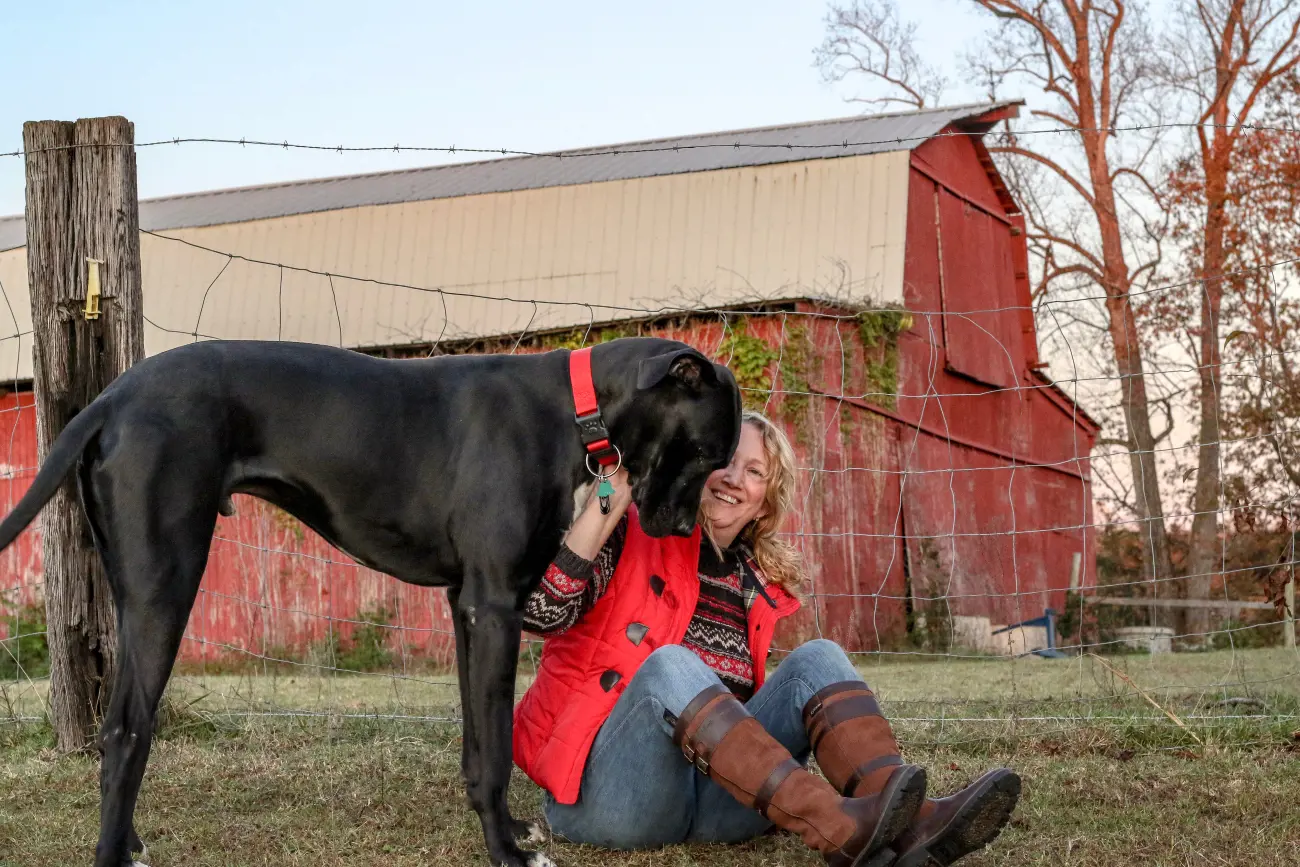What are these scabs on my dog’s skin?
5th April, 2023

Is your playful pup forever getting scabs? Learn how to treat and clean them and how to spot the signs they could be something more serious.
You’re pampering your pup with a soapy warm bath when you feel something hard on its skin – a scab! The more your rub in the suds, the more scabs you feel.
As a loving pet parent, it’s normal to be concerned. When did they get them? How? Is it serious? Don’t panic. Most of the time it won’t be anything serious, but it’s always good to check.
In this article, we’ll discover some of the reasons your pooch can get scabs and when it’s time for a visit to the vet. We also share why protecting your pup with dog insurance is a must to make sure they get the emergency care they need.
What do dog scabs look like?
Before we jump into what causes these lesions, you need to know what you’re looking for. Scabs come in all shapes and sizes, but they tend to look:
- Reddish-brown
- Like bumps and blisters
- Dry, hard and flaky
On a short-haired breed, they’re easy to spot, but if you have a long-haired dog, you might need to push fur out of the way to see them. You can usually feel them when stroking and massaging your pup, especially at bath time.
What causes scabs on dogs?
Your dog won’t stop scratching and is just making the situation worse! But to treat the scabs, you need to know the cause.
Here are some of the most common reasons for scabs.
Fleas
Small, dark, blood-sucking pests – just hearing the word fleas is enough to make you start itching, so imagine how your dog feels covered in the tiny bugs!
Your pup can become host to these pests when they jump from another animal at the park, and before long, they can’t shake the itch. Constant scratching leads to small cuts and scabbing over flea bites, causing a skin infection.
Fleas can also affect humans and get into your furniture, so ask your vet for treatment for your dog and give your home a thorough clean, too. We’ve got plenty more tips to get rid of the pests on our blog.
Allergies
Just like us, dogs are susceptible to various allergies, including those from the environment, like pollen and dust, as well as food allergies and contact dermatitis. All these causes can make your dog’s skin itch like crazy, leading to sores and scabs.
Allergies can be hard to diagnose, so a visit to the vets is on the cards if you’re not sure why they’re itching. Depending on the cause, your pet will likely need treatment and for you to minimise its exposure to the allergen to prevent further problems.
Skin infections
The most common scab-causing infection in canines is mange. Tiny mites burrow into your pup’s skin, causing intense itching and hair loss – not nice, we know!
According to The Kennel Club, there are a few types of mange and mites that lead to skin infections in dogs:
- Scabies (sarcoptic mange)
- Demodex (demodectic mange)
- Ear mites (You may even want to learn how to bandage a dog's ear tip and you can do so elsewhere on our site)
- Harvest mites
- Cheyletiellosis
Take your pet to the vet for tests and a diagnosis to get the right treatment.
Dandruff
If you’ve ever experienced dandruff, you know what an itch it creates! Dogs get dandruff (or ‘scruff’) because of dry skin, but it can also signal an underlying infection, so get them seen by your vet.
Canines with especially dry skin might experience harsher symptoms during winter (get help to prepare your puppy for winter elsewhere on our site) or from eating a poor diet. To keep their skin and coat healthy, they need plenty of protein and omega 3 and 6 fatty acids.
Dandruff is usually easy to treat with shampoos from the vet, but underlying causes will need further care.
Other health conditions
There are lots of other medical concerns that cause your dog to itch and scabs to form, ranging from mild to serious:
- Yeast infection
- Immune system diseases
- Parasites
- Cancer
Without a proper diagnosis, you won’t know what’s wrong with your poorly pooch to help them get better. That’s why you should always take them to the vet.
Worried about the costs of care and treatment? Specialist dog insurance can help with that!
Should I be worried about a scab on my dog?
The odd scab here and there is usually nothing to worry about. Your pet might have had a simple itch or got a small lesion while on a walk.
If you notice a lot of scabs on your dog, though, take them to the vet. It’s better to be safe and rule out something serious than play the waiting game to see if it gets worse.
How to treat scabs on dogs
First, your vet will need to diagnose the cause of your dog’s scabs to stop them from itching so much. If your pup scratches a lot and causes scabs to bleed, they might need to wear an Elizabethan collar or a dog cone until they clear up to prevent infection.
Treatment for the scabs themselves can include:
- Medicated shampoos
- Antibiotics
- Oral allergy treatment
- Steroids
Treatment for scabs should soothe your dog’s skin, reduce inflammation and stop them from scratching so much.
3 ways to help treat scabs on a dog's skin

Jennifer Macindoe, BVMS MRCVS
Veterinary Surgeon1: If mild, use saline (1 tsp salt / 500ml cooled boiled water) to clean scabs one to two times daily. Dry thoroughly afterward. 2: Using Chlorhexidine solution 1-2 times daily. This is an antibacterial product that can be used on its own (diluted) but it’s also available in many shampoos, mousses, and gels that are specifically designed for dogs. 3: Preventing self-trauma is an important way to reduce scabs. Use a buster collar or pet medical suit to reduce any excessive licking, biting, or scratching at the skin.
How to clean scabs on your dog

Whatever the reason for your dog’s scabs, they need to be kept clean and dry to promote faster healing and reduce the risk of infection – here’s how:
- Trim the fur: Unless your dog has lost its hair around the scab, give the surrounding fur a small trim to see the extent of the scab’s condition and keep it clean.
- Rinse with warm water: Moisten the scab with a warm, damp cloth to soften crusty scabs and wash away irritants.
- Apply medication: If your vet prescribed treatment to apply to scabs, do so once you’ve properly cleaned the area.
- Keep it moist: If the scab is small, cover it with a gauze to stop it from drying out. If the area is too big, you can use an oil that’s safe for dogs to lick.
Can I prevent scabs on my dog?
It can be hard to keep your canine companion scab-free, especially if they love a good gambol outdoors, but you can minimise the chances by:
- Keeping up to date with your dog’s vaccines to protect them from disease.
- Grooming your pup regularly to reduce the amount of debris and dirt in their coat that could cause itching – we’ve got tips on caring for your dog’s coat.
- Staying away from areas with a high concentration of other animals to lower the risks of fleas.
Can humans catch skin conditions from a dog?
It depends on the cause. Allergies and certain diseases aren’t contagious and there’s no risk to humans, but fleas can easily bite you if your dog is a host. You can also become infected by parasites, so staying up-to-date with your dog’s flea and worming treatments are a must to reduce the chances.
The Blue Cross says that we can catch sarcoptic mange from dogs, but they won’t complete their life cycle on humans (thankfully), so irritation is short-lived. If your pup has this condition, keep them off the furniture and avoid close contact until the infection clears.
What are the signs of skin problems in dogs?
Itching is the most obvious sign your dog’s got a skin condition, but it’s not the only one. Some of the other symptoms that warrant a trip to the vet are:
- Skin sores and lesions
- Rashes
- Dry and flaky skin
- Lumps and bumps
- Redness
- Dandruff
- Excessive licking
- Bald patches and hair loss
- Hot spots of inflammation
If you notice the occasional scab on your pup and aren’t sure whether you need to see the vet or not, why not use our 24-hour vet video consultation service with Joii? All our lifetime dog insurance plans come with unlimited, around-the-clock access so you can get answers quickly.
Preventative measures to reduce inflammation of the skin

Jennifer Macindoe, BVMS MRCVS
Veterinary Surgeon1: As fleas and flea allergies are common causes of inflamed skin, keep your dog up to date with regular parasite preventatives. 2: If your dog is prone to allergies or scabs, bathing with an antibacterial shampoo (containing Chlorhexidine) every 7-10 days can help reduce inflammation of the skin. 3: Feed your dog a balanced food, suitable for their age and lifestyle. Food allergies can cause skin problems in dogs, and a novel protein or anallergenic food is usually necessary for diagnosis.
How often should I bathe my dog?
Bathing your dog too much can wreak havoc with their skin. Shampoo dries out your pup’s dermal layer, stripping it of natural oils and leaving it itchy, which could cause scabs and eventually a skin infection.
Unless your vet recommends otherwise, it’s best to bath them every two or three months. If your pooch is particularly dirty or smelly before then, it’s fine to wash them in the tub, but use specially formulated doggy shampoo and conditioner for their sensitive skin.
Dog insurance for your playful pup
However active your dog is, they’re bound to get the odd scab now and again. Unless you know it’s from a scrape at the park, it’s always worth a visit to the vet to rule out anything serious.
Protecting your pet with dog insurance while they’re still healthy means you can get the best care possible in those unexpected situations without having to worry about vet bills.
Why choose Purely Pets to look out for your canine companion?
We believe every dog deserves the best protection whatever their age, which is why we only offer lifetime dog insurance plans.
Our 24/7 vet video service is always there for quick advice and managing your policy and claims through our online portal couldn’t be easier.
To give your pup the protection it deserves, get a dog insurance quote today.
Helpful Pages
Recent Posts

Why do Great Danes bury their heads?
12/03/25
Find out more about Beagles
28/02/25Pet Insurance Quote
- 98% claims paid *
- Claims paid directly to vets
- 24/7 vet video consultations
- Interest free monthly payments


